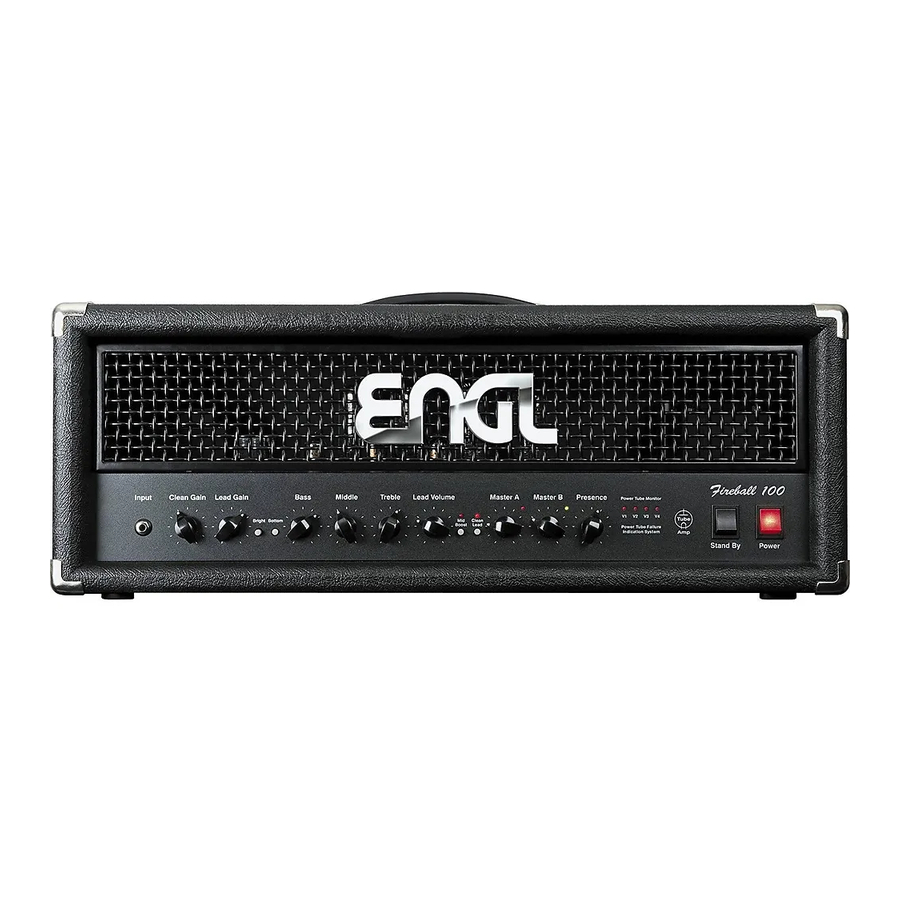Summary of Contents for Engl Fireball 100
- Page 1 Tube Tube Fireball 100 Full Tube Guitar Amplifier Operator´s Manual Please, first read this manual carefully!
-
Page 2: Front Panel
Fireball is no exception. On that note, please read and heed the guidelines on handling all-tube amps. You'll find them on the last page of this manual. The ENGL team is convinced that the Fireball amp will delight and inspire you - just plug in your guitar and play! - Page 3 If your arsenal includes MIDI gear - for instance, the Z-11 ENGL MIDI Switcher in combination with a MIDI Footswitch (e.g ENGL Z-9, Z-12, Z-15) - you may use the amp's Master A/B circuit to swiftly and conveniently set the power amp's volume to two different levels, and then access these volume presets in combination with preamp voicing features such as Mid Boost.
- Page 4 15a Power Tube Monitor V1 This LED lights up when the current flowing through the V1 power amp tube is too high and the power tube monitor system has switched that tube off. See the tube layout chart to locate V1's position on the amp chassis. 15b Power Tube Monitor V2 This LED lights up when the current flowing through the V2 power amp tube is too high and the power tube monitor system has switched that tube off.
-
Page 5: Rear Panel
Use this 1/4" Stereo jack to connect a conventional footswitch with two switching functions, for example, the ENGL Z-4 (2 x off/on - Single Pole Single Throw or SPST for short). This type of footswitch lets you access Mid Boost and FX Loop off/on. One of the two switches activates Mid Boost, while the the other activates the FX Loop. - Page 6 22 Noise Gate Threshold: A Tip from the Designer - continuation The most common source of noise is 50 Hz or 60 Hz (hertz/cycle) mains hum, particularly when the guitar is positioned near transformers and power units. Because in worst-case scenarios this humming can attain extremely high levels, the Noise Gate can hardly distinguish between the musical signal and noise.
-
Page 7: Wiring Of Principal Connectors
ON/OFF ON/OFF 1. Two-way footswitch (e.g. ENGL Z-4): Connect it to the amp via a stereo ¼" cord. You will need one two-way footswitch for switching channels via Jack 21 and Master A/B another footswitch for switching Mid Boost and FX Loop off/on via Jack 20. -
Page 8: Technical Data
Technical Data: Rated power: approx. 100 watts at 4, 8 or 16 ohms; Input sensitivity level Input, Clean channel: -20 dBV nominal, max. 0 dBV Input sensitivity FX RETURN: from -20 dBV to -10 dBV nominal, max. 0 dBV Output level FX SEND, level range: from -20 dBV to -10 dBV nominal, max. -
Page 9: Troubleshooting
(Refer to "Wiring of Principal Connectors" for pin assignments.) -> If you are using footswitches other than an ENGL Z-4 or Z-11, are the switches or relays inside the boards or switching loop systems off / on Single Pole Single Throw (SPST) switches? In other words,... - Page 10 Sound setting samples - Clean channel Input Clean Gain Lead Gain Bass Middle Treble Lead Volume Master A Master B Presence Power Tube Monitor Tube Bright Bottom Clean Boost Lead Power Tube Failure Indication System Stand By Power Sound sample 1: Crystal Clean Input Clean Gain Lead Gain...
- Page 11 Sound setting samples - Lead channel Input Clean Gain Lead Gain Bass Middle Treble Lead Volume Master A Master B Presence Power Tube Monitor Tube Bright Bottom Clean Boost Lead Power Tube Failure Indication System Stand By Power Sound sample : Vintage Blues Crunch Input Clean Gain Lead Gain...
-
Page 12: Handling And Care
Running the amp at mains voltages exceeding the nominal mains input voltage over longer periods can also shorten component life. * Replace tubes with selected tubes that satisfy ENGL selection criteria to forestall microphonic properties, undesirable noise and unbalanced power amp signals.

















Need help?
Do you have a question about the Fireball 100 and is the answer not in the manual?
Questions and answers